The King Fanless Intel Core i5 6x 2.5GbE CWWK System Performance
As with all of these reviews, we wanted to look at performance quickly. We installed Ubuntu to validate Linux worked but also to provide some performance comparison with other offerings. We also had Windows 11 Pro installed for some of the storage testing.
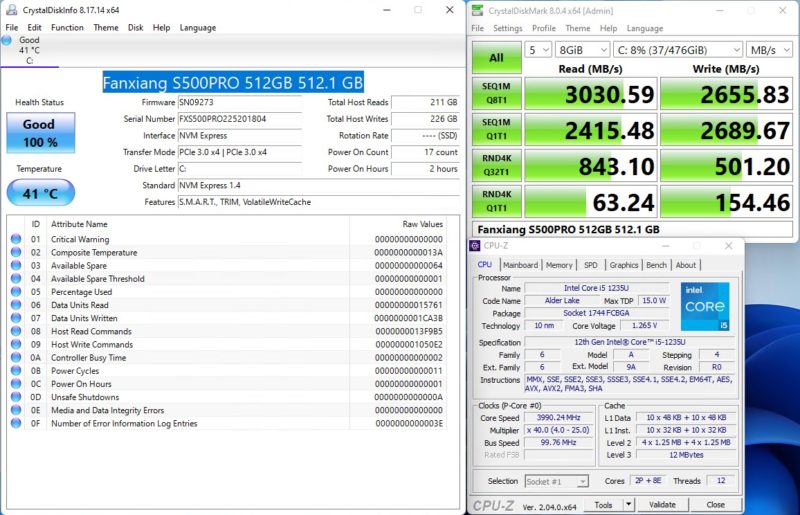
The included Fanxiang S500PRO 512GB NVMe SSD was a PCIe Gen3 unit but it performed fairly decently. We used the included SSD as our Windows 11 Pro SSD, then added a second SSD, a cheap WD Blue 1TB drive (affiliate link) to run other OSes. We generally advise using lower-power drives here and sacrificing performance for fanless systems.
Still, the big feature we wanted to look at is the Intel Core i5-1235U to see how it performs.
Python Linux 4.4.2 Kernel Compile Benchmark
This is one of the most requested benchmarks for STH over the past few years. The task was simple, we have a standard configuration file, the Linux 4.4.2 kernel from kernel.org, and make the standard auto-generated configuration utilizing every thread in the system. We are expressing results in terms of compiles per hour to make the results easier to read:
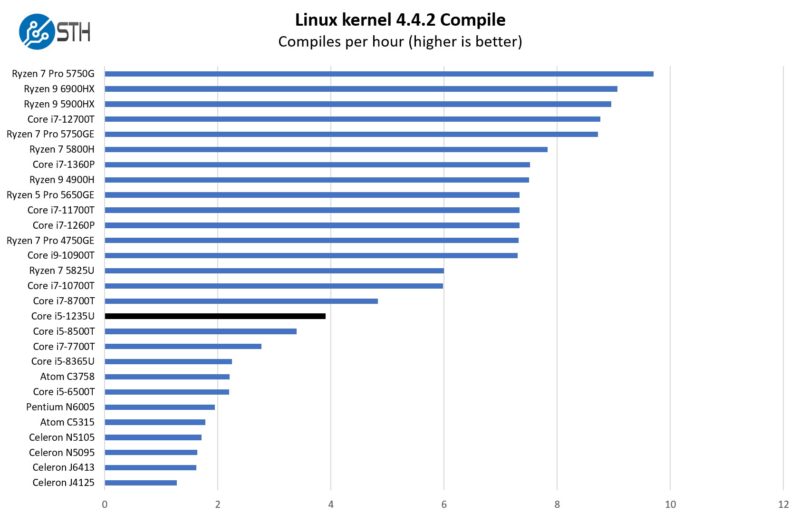
The first thing we noticed was the massive jump between this Intel Core i5-1235U and the Intel Core i5-8365U. Performance-wise, the mix of P-cores and E-cores is outpacing not just the older 15W parts, but also Project TinyMiniMicro 35W TDP parts.
7-zip Compression Performance
7-zip is a widely used compression/ decompression program that works cross-platform. We started using the program during our early days with Windows testing. It is now part of Linux-Bench.
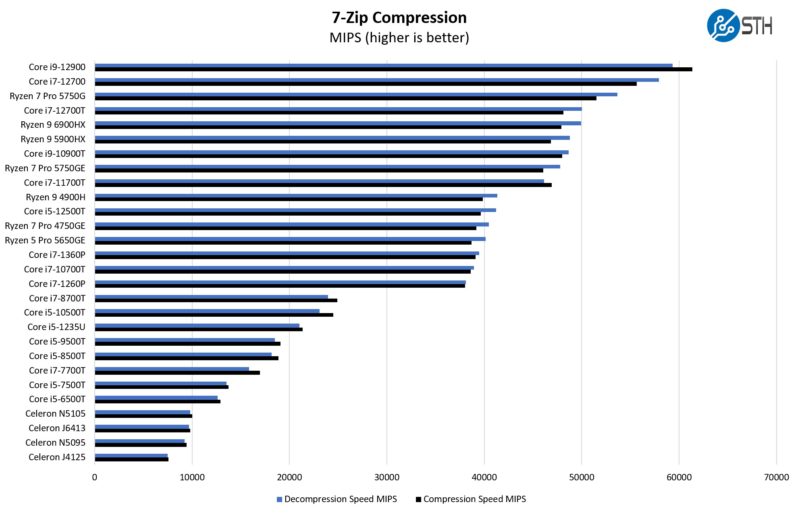
Compared with the Intel J6413 or the Intel N5105 parts that we have looked at, we are getting >2x the performance. Part of that is having more cores. Part is having a 50% higher TDP.
OpenSSL Performance
OpenSSL is widely used to secure communications between servers. This is an important protocol in many server stacks. We first look at our sign tests:
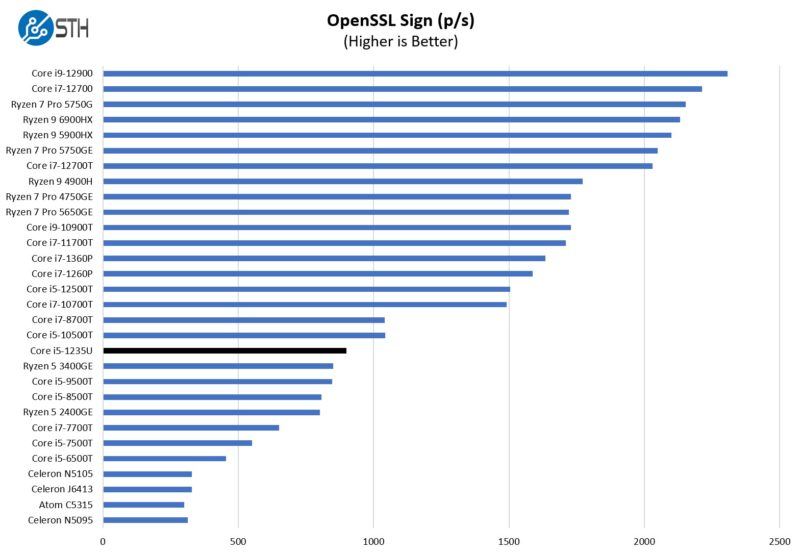
Here are the verify results:
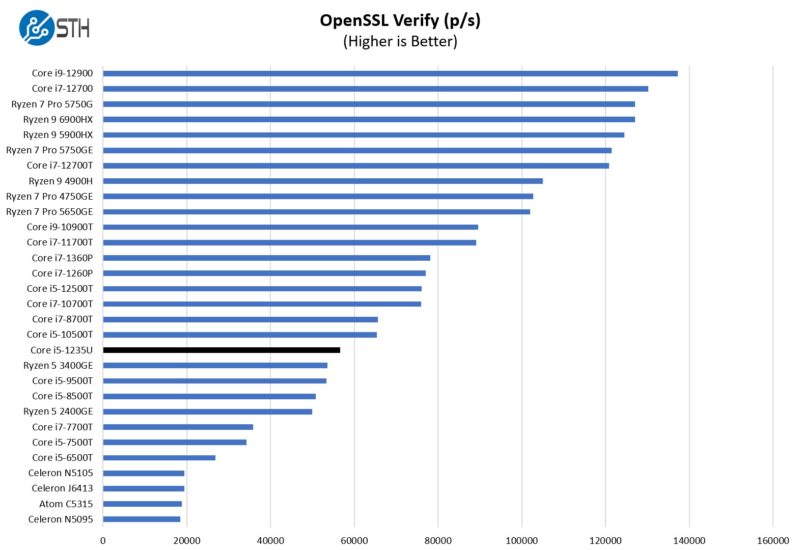
Having the Alder Lake generation P-cores and E-cores is really nice. These systems are not overly well-tuned for performance, but we are getting good results out of the box.
Geekbench 6 Results
Just to put a bit of a finer point on this one, we wanted to take a look at the Geekbench 6 results.
Here is a quick look at this unit, versus the Lenovo ThinkCentre M80q Tiny Gen 3 that we just reviewed.
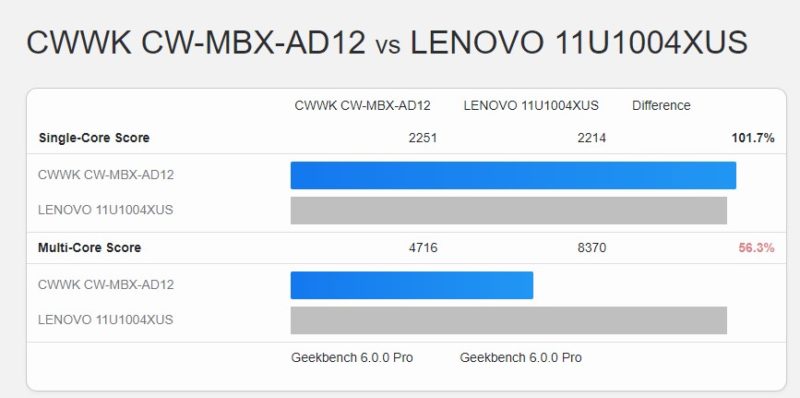
One can see we have similar single-thread performance, but around half the multi-thread performance of the 35W TDP Intel Core i5-12500T.
Compared to some of the other firewalls with the N5105 and N6005, we are going to use the N6005-based iKoolCore R1 for our comparison:
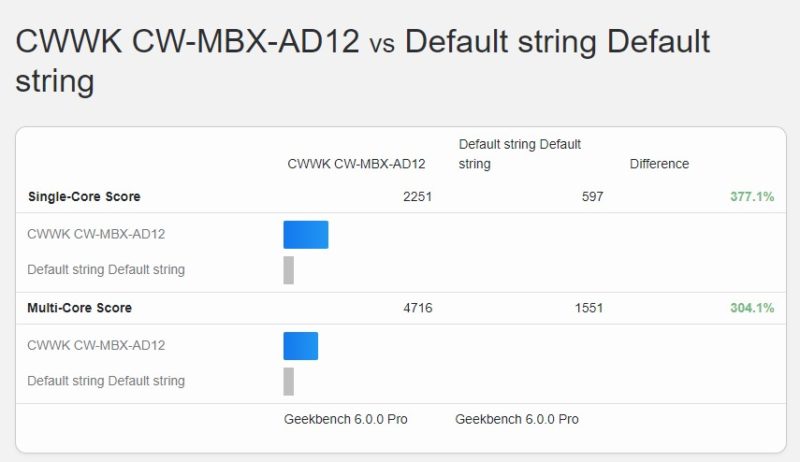
Here we can see a 3-4x performance jump over an actively cooled N6005. Of course, the iKoolCore R1 is much smaller, and that is the point, but we are comparing it to a higher-power and fanless node.
The N6005 is generally plenty for 2.5GbE firewalls/ routers running pfSense or OPNsense. At the same time, there are many power users that simply want more performance because they have more firewall rules or services running. This is the kind of machine that has a lot of extra performance just because of the P-core and E-core architecture. It also has the newer Intel Xe GPU solution for those who are looking for desktops or even just Quick Sync video transcoding.
Just using the Core i5, with the upgraded Intel graphics was a much better experience. The N5105/ N6005 desktop experience is “OK” but it can be frustratingly slow. On the Intel Core i5-1235U, it feels fairly close to a Project TinyMiniMicro 35W PC. That is the awesome part about having P-cores that were fairly consistently hitting 4GHz turbo speeds in short bursts. A 4GHz turbo Alder Lake P-core burst is very good.
Next, let us talk about power consumption and noise.




No testing of the max network throughput? It has six NICs so I’m sure folks are curious. I’m not expecting line rate but it’d be good to know where the ceiling is.
Huh? The N6005’s with four older E cores do line rate on 2.5GbE NICs if you’ve got dual ch mem installed. This is much faster than that.
Even with 64kB packets? All 6 NICs forwarding traffic at 2.5Gbps all at once? Maybe I’m just out of touch with what these CPUs are capable of.
“Something very cool.”
I see what you did there. Have an upvote.
vPRO Enterprise would make it really interesting.
You keep implying that the higher i7 variants won’t be worthwhile on TDP/heat limited designs, because they’ll just be throttled anyway… effectively killing the frequency advantage.
Sure, there will be diminishing returns, but as with all these mobile parts, in this case with the i5-1235U and the i7-1265U there, will still be a significant performance difference–at the very same TDP or heat point.
The difference between the two is no longer just Intel cutting certain fuses to provide a spread for every niche in the market (not that that’s gone away completely). At least part of it is really just binning and that’s really rather analog these days and not just about transistors working or not or chips failing to function beyond a certain speed.
While that can obviously happen, binning is mostly about the quality and impedance of wire-transistor interconnects and how they’ll require a bit more voltage (or not) to push signals at a given frequency. And of course, higher voltages imply higher power consumption, which also has chips failing eventually, but it’s the power budget that seems to be the more significant hurdle for binning.
E.g. in Skylake/Kaby-Lake times hyperthreading wasn’t cut for some bins because some transistors weren’t working, but mostly because it helped keeping the power budget in check. Real chip defects on the other hands could “crater” cache SRAM banks or full cores, so these i3-1215U could really be that type of salvaged chips—or require 30 Watts to run with fully enabled cores: too high to sell in a mobile space for 2P performance.
A lot of these i5-1235 might have no issue reaching “i7-1265 frequencies” or in fact higher yet, but they’d get hotter in comparison and at a certain point too hot for the platform constraints.
So on a mobile platform, those i7 will generally get you more overall compute out of the same battery power as well as a bit more peak, while on a passive heat constrained platform it’s more about the level and the length at which peak and sustained performance can be maintained.
Paying more for the i7 will almost certainly give you more performance in one way or another, than what you can get on the i5. Whether that those additional Hertz justify the extra $$$ is mostly a personal question, not technical.
I tend to re-purpose hardware; few systems ever get to serve out their life-time in the very use case for which they were bought. So, for me to aim a little higher on the parts isn’t a guaranteed waste, but often an opportunity to remain usable on a new job. It obviously doesn’t mean I’ll always aim for the top spot, either, or only when prices have stopped being crazy.
The most extreme examples of how far binning could spread from my past personal experience where Yorkfield/Harpertowns Quad-Cores, which Intel made around 2007/8 in a shrink of the 65nm designs to 45nm. Early Q9550 (2.83GHz) didn’t actually do much better than their Q6600 65nm (2.66GHz) predecessors, both balked at being pushed to the then magic 3 GHz, mine got hot and failed very quickly, others were luckier.
I had plenty of these for my kids so when I was hunting for a cheap way to extend the platform’s life-time I found Xeon X5492 being sold off for a pittance as well as ways to have LGA 771 chips fit into an LGA 775 socket (+ BIOS patches to make them work).
These Xeons were the truly golden sample Harpertowns/Yorkfield chips, the very best bin ever made on that 45nm process and even proclaimed that on their CPUID. While their official rating was 150 Watts of TDP, quite a lot for that socket at the time, they never came near that power consumption. Instead, they ran a very cool 50 Watts on Prime95 loads and reached 3.4 GHz and 1.6GHz FSB without breaking even a sweat on a box cooler.
They were mostly identical to the Core 2 Extreme QX9775, which officially only ran at 3.2 GHz also with 150 Watts of TDP, but that had an unlocked multiplier allowing them to complete Prime95 at 4GHz with some overclockers out there.
The gap between my first Q9550 which refused to do 3 GHz and those golden samples was more than 40%, which is why the industry then went into Turbo mode and monetized those bins to the utmost.
Are these 6 NICs bonded together which typically will result in better switching performance? Or are these all having to go through the CPU in order to move LAN traffic between ports? It looks like they’re all wired to the CPU, which kinda sucks for performance. I know you’ve recently reviewed some similar NUCs that have their LAN ports all wired up together to offload traffic from the CPU, but I don’t think any of them were 2.5Gbe based.
Thanks!
Justin C.
It looks to me that the advantage of the i7-1265U is V-Pro because the support of AMT, which means out-of-band management, but I guess this needs some support from the BIOS. Anyone tested that from any of those Aliexpress products?
Anyone got a problem with the power connector from those Aliexpress products, that just touching a bit the connector of the power supply, the computer gets reset? Returning the product for something that looks simple to solve will be pity!
I have this one for my lab I was running pfsense on it but it became to much of a headache so now I’m playing around sure a proxmox ve server on it. Currently running home assistant and Nas storage. I was going to is it as a router but now I just use it to play and around with. Thinking about installing windows 11 pro on it and utilizing hyper v. I attempted to install esxi but was having trouble with the big little architecture. I tried editing the install to prevent kernel panic with no luck.